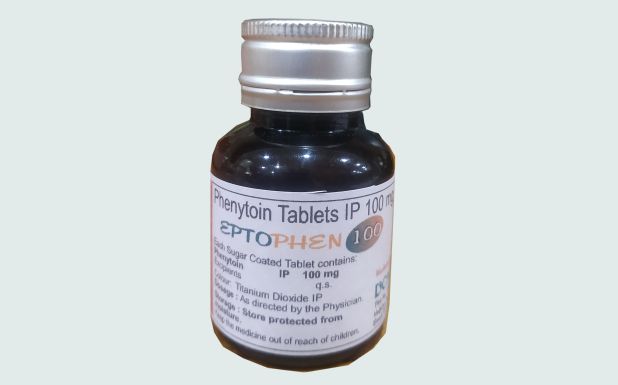
Composition
- Each sugar coated tablet contains:
- Phenytoin IP 100 mg
Packing
- 120
Tablets
MRP
- 209.66
Overview
Phenytoin is one of a group of medicine called anti – epileptic drugs; these medicines are used to treat
epilepsy. It belongs to the family of medicines called anticonvulsant. It acts in the brain to block the spread of seizure activity.
Phenytoin Sodium 100 mg film coated tablet can be used to control a variety of epileptic conditions, to
control or prevent seizures during or after brain surgery or severe head injury. It can also be used to treat
trigeminal neuralgia (facial nerve pain).
Indications
Phenytoin Sodium Tablet is indicated for the control of:
- Generalized tonic-clonic (grand mal)
- Complex partial (psychomotor, temporal lobe) seizures, and
- Prevention and treatment of seizures occurring during or following neurosurgery
Mechanism of Action
Phenytoin is an antiepileptic drug which can be useful in the treatment of epilepsy.
Through hyperpolarisation it stabilizes the membranes of the central and peripheral nerves and thereby prevents spread of seizure activity rather than abolish the primary focus of seizure discharge. An increase in inhibitory impulses contributes to the anticonvulsive effect.
It appears to stabilise rather than raise the seizure threshold and prevents spread of seizure activity rather than abolish the primary focus of seizure discharge.
The mechanism by which phenytoin exerts its anticonvulsant action has not been fully elucidated however, possible contributory effects include:
1. Non-synaptic effects to reduce sodium conductance, enhance active sodium extrusion, block repetitive firing and reduce post-tetanic potentiation.
2. Post-synaptic action to enhance gaba-mediated inhibition and reduce excitatory synaptic
transmission.
3. Pre-synaptic actions to reduce calcium entry and block release of neurotransmitter.
Pharmacokinetics
Phenytoin is absorbed from the small intestine after oral administration. Various formulation factors may affect the bioavailability of phenytoin, however, non-linear techniques have estimated absorption to be essentially complete. Bioavailability is subject to large inter-and intra-individual fluctuations.
Following a single dose, the maximum plasma a level is generally achieved after 4 to 6 hours (range 3 to 12 hours).
After absorption it is distributed into body fluid including CSF. Its volume of distribution has been estimated to be between 0.52 and 1.19 litres/kg, and it is highly protein bound (usually 90% in adults). In neonates plasma protein-binding is reduced.
Since phenytoin obeys saturation kinetics, the half-life is dependent on the plasma level. Plasma half life is between 20 and 60 hours; it is normally shorter in children; a prolonged half life can be expected in premature and newborn babies as well as with toxic dosages. The therapeutic range for plasma concentration is generally between 10 and 20 μg/ml. Steady state therapeutic drug levels are achieved at least 7 to 10 days after initiation of therapy.
95% of phenytoin is biotransformed. Phenytoin is hydroxylated in the liver by an enzyme system which is saturable. Small incremental doses may produce very substantial increases in serum levels when these are
in the upper range of therapeutic concentrations. The main metabolite is the glucuronide of the p-
hydroxy-diphenyl-hydantoin, which circulates in the entero-hepatic circulation.
The parameters controlling elimination are also subject to wide inter-patient variation. The serum level achieved by a given dose is therefore also subject to wide variation.
Phenytoin passes through the placenta and reaches similar concentration in the fetal and maternal plasma. Phenytoin accumulates in the liver of the fetus.
Contraindication
Phenytoin is contraindicated in those patients who are hypersensitive to phenytoin or other hydantoins.
Drug Interaction
Drugs which may increase phenytoin serum levels include: acute alcohol intake, amiodarone,
chloramphenicol, chlordiazepoxide, cimetidine, diazepam, dicumarol, disulfiram, estrogens,
ethosuximide, fluoxetine, H2-antagonists, halothane, isoniazid, methylphenidate, phenothiazines, phenylbutazone, salicylates, succinimides, sulfonamides, ticlopidine, tolbutamide, trazodone.
Drugs which may decrease phenytoin serum levels include: carbamazepine, chronic alcohol abuse,
reserpine, and sucralfate. Molindone Hydrochloride contains calcium ions which interfere with the absorption of phenytoin. Ingestion times of phenytoin and antacid preparations containing calcium should be staggered in patients with low serum phenytoin levels to prevent absorption problems.
Drugs which may either increase or decrease phenytoin serum levels include: phenobarbital, sodium valproate, and valproic acid. Similarly, the effect of phenytoin on phenobarbital, valproic acid, and sodium valproate serum levels is unpredictable.
Pregnancy & Lactation
Please ask the doctor if you are pregnant. Infant breast-feeding is not recommended for women taking this drug because phenytoin appears to be secreted in low concentrations in human milk.